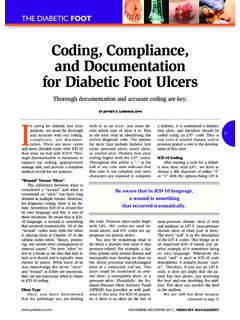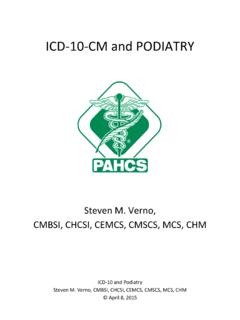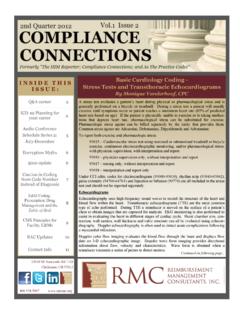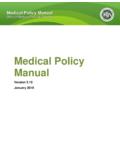Transcription of Coding, Compliance, and ... - Podiatry Management
1 2017 | Podiatry Management 71a diabetic, it is considered a diabetic foot ulcer, and therefore should be coded using an L97- code. This is true even if arterial disease and/or pressure played a role in the develop-ment of this Coding After starting a code for a diabet-ic foot ulcer with L97-, we have to choose a 4th character of either 4 or 5 with the options being (non-pressure chronic ulcer of heel and midfoot) or (non-pressure chronic ulcer of other part of foot). The word and is in the description of the codes. This brings us to an important ICD-10 lesson and an-other example of it sometimes being its own language. Whenever the word and is used in ICD-10 code descriptions, it actually means and/or . Therefore, if you use an code, it does not imply that the pa-tient has two ulcers, one involving the heel and one involving the mid-foot.
2 The ulcer can involve the heel or the midfoot. We are still not done because In caring for diabetic foot ulcer patients, we must be thorough and accurate with our coding, compliance, and documen-tation. There are more codes and more detailed codes with ICD-10 than what we had with ICD-9. Thor-ough documentation is necessary to support our coding, appropriately manage risk, and provide a complete medical record for our patients. Wound Versus Ulcer The difference between what is considered a wound and what is considered an ulcer has been long debated in multiple forums. However, for diagnosis coding, there is no de-bate. Sometimes ICD-10 is almost like its own language and this is one of those situations. Be aware that in ICD-10 language, a wound is something that occurred traumatically. All of the wound codes start with the letter S, placing them in Chapter 19 of the tabular index titled, Injury, poison-ing, and certain other consequences of external causes.
3 The term ulcer re-fers to a break in the skin that fails to heal as it should and is typically more chronic in nature. While many of us may interchange the terms ulcer and wound as if they are synonyms, they are not synonyms when it comes to ICD-10 Type Once you have determined that the pathology you are dealing with is as an ulcer, you must de-cide which type of ulcer it is. This is the next step in identifying the correct diagnosis code. The options for ulcer type include diabetic foot ulcer, pressure ulcer, stasis ulcer, or arterial ulcer. Diabetic foot ulcer coding begins with the L97- codes. Throughout this article a - at the end of any code stem indicates that this code is not complete and more characters are required to complete the code. Pressure ulcer codes begin with L89-. I83- codes are used for stasis ulcers, and I70- codes are ap-propriate for arterial ulcers.
4 You may be wondering what to do when a diabetic foot ulcer is also pressure-related. For example, a dia-betic patient with arterial disease and neuropathy may develop an ulcer on the dorsal proximal interphalangeal joint of a contracted 2nd toe. This ulcer could be considered an arte-rial ulcer, a neuropathic ulcer, or a pressure ulcer. Thankfully, the Na-tional Pressure Ulcer Advisory Panel (NPUAP) has provided us with guid-ance in this area. For ICD-10 purpos-es, if there is an ulcer on the foot of Thorough documentation and accurate coding are , Compliance, and Documentation for Diabetic Foot UlcersBy Jeffrey D. Lehrman, DPmBe aware that in ICD-10 language, a wound is something that occurred on page 72 THE DIABETIC 2017 | Podiatry Management 72 THE DIABETIC fOOTditional code. If the patient is on diabetic medication, the and/or code should be listed after If this is not something you have been asking your type 2 dia-betic patients, you may be surprised how many type 2 diabetics are now taking insulin as compared to ten or more years ago.
5 If the patient is not on any type of diabetic medication, neither of these need to be coded. If the patient is on both types of diabet-ic medication, both of these should be coded. If the patient is a type 1 di-abetic, you will see that does not carry this instruction to use a z code. Let s go through the diagnosis coding of a type 2 diabetic patient taking daily insulin for a chronic left lateral midfoot ulcer with ne-crosis of muscle. When coding this encounter, you would start with because this ulcer is on the midfoot. The 5th character would be 2 because it is the left foot, and the 6th character would be 3 because there is necrosis of muscle. That leaves us with , which carries the instruction to code first (type 2 diabetes mellitus with foot ulcer). Because this patient uses daily insulin, is necessary as well.
6 Following the rules of code first and use additional code , the order of these codes would be first, second, and Coding After the diagnosis code is com-plete, the next step is to identify the Current Procedural Terminolo-gy (CPT) code for the debridement that was performed. There are four once you have decided on a 4th character, a 5th character is required and the 5th character options are listed in Table 1. This code is not complete after selecting the 5th character because a 6th character is required. The 6th character codes are listed in Table 2. You will notice the unspecified options in these 5th and 6th character listings. An unspecified selection indicates to the payer that the documentation was incomplete, and should almost always be avoided as this may lead to denial of payment. With the 5th character laterality options, for ex-ample, a selection of 0 would in-dicate that neither left nor right was specified in the documentation.
7 Notice in the 6th character op-tions for and (Table 2) that 1 and 2 reference the depth of the ulcer, but 3 and 4 refer-ence the depth of tissue that is ne-crotic. Just because an ulcer extends to a certain depth does not necessar-ily mean there is necrosis of tissue to that depth. Multiple agencies, in-cluding the American Podiatric Med-ical Association and the Alliance of Wound Care Stakeholders have sub-mitted requests to the World Health Organization to make changes to the code descriptions that would address this inconsistency but no changes have been made. The coding of a diabetic foot ulcer is still not complete after the 4th, 5th, and 6th characters have been chosen because the L97- codes require you to code first any as-sociated underlying condition, such as (among others) diabetic ul-cers ( , , , , , , , , , ).
8 Of these options, the most commonly used codes for di-abetic foot ulcers are (Type 1 diabetes mel-litus with foot ulcer) and (Type 2 diabetes mellitus with foot ulcer). Code first indicates that an additional code is required, the orders matter, and you should list this code first. Therefore, or should precede the L97- code on the claim form. In a Type 2 diabetic with a foot ulcer, we may still not be finished because carries with it the instruction to use additional code to identify control with insulin ( ) or oral hypoglycemic drugs ( ) . Just as the order matters when we see code first , the order in which the codes are listed is im-portant when instructed to use ad-Documentation (from page 71)Continued on page 745th character options for 5th character options for Unspecified heel and midfoot 0 Unspecified foot1 Right heel and midfoot 1 Right foot 2 Left heel and midfoot 2 Left footTABLE 16th character options for and codes 1 Limited to breakdown of skin 2 With fat layer exposed 3 With necrosis of muscle 4 With necrosis of bone 9 With unspecified severityTABLE 2 With the 5th character laterality options, for example, a selection of 0 would indicate that neither left nor right was specified in the 2017 | Podiatry Management 74 THE DIABETIC fOOTmoved from one ulcer and 6 sq.
9 Cm. of subcutaneous tissue is removed from another ulcer, then both CPT 97597 and CPT 11042 should be used to represent the two different depths. If over 20 sq. cm. of tissue is removed at any depth, then an add-on code becomes necessary. The add-on codes for each of the depths are listed in Table 4. By definition, 51 and 59 modifiers should not be used with add-on codes. Note that the number of units of each add-on code submitted is determined by the base codes to choose from when an ulcer debridement is performed (Table 3). The code you choose from Table 3 is determined by the deepest layer of tissue that is removed during the debridement. The depth of the ulcer itself does not determine the code selection, but rather the deepest depth to which the debridement is performed. For example, you may be treating an ulcer with bone exposed at its base, but if the deepest layer to which you debride is subcutaneous tissue, CPT 11042 would be the ap-propriate code.
10 The amount of tissue removed is also important when selecting the CPT code. The codes listed in Table 3 are used if a total of 20 sq. cm. or less of tissue is removed at that depth. If multiple ulcers are debrid-ed at the same depth, the amount of tissue removed from all of them should be totaled to determine the appropriate code. If more than one ulcer is debrided at different depths, then different codes can be used to represent each depth. For example, if 4 sq. cm. of dermis is removed from one ulcer and 6 sq. cm. der-mis is removed from another ulcer, a total of 10 sq. cm. of dermis has been removed and the appropriate CPT code would be one unit of CPT 97597. If 4 sq. cm. of dermis is re-The depth of the ulcer itself does not determine the code selection, but rather the deepest depth to which the debridement is (from page 72)Continued on page 76 CPT 97597 Debridement (eg, high pressure waterjet with/without suction, sharp selective debridement with scissors, scalpel and forceps), open wound (eg, fibrin, devitalized epidermis and/or dermis, exudate, debris, biofilm), including topical application(s), wound assessment, use of whirlpool, when performed and instruction(s) for ongoing care, per session; total wound(s) surface area; first 20 sq cm or lessCPT 11042 Debridement, subcutaneous tissue (includes epidermis and dermis, if performed); first 20 sq cm or lessCPT 11043 Debridement, muscle and/or fascia (includes epidermis, dermis, and subcutaneous tissue, if performed).








